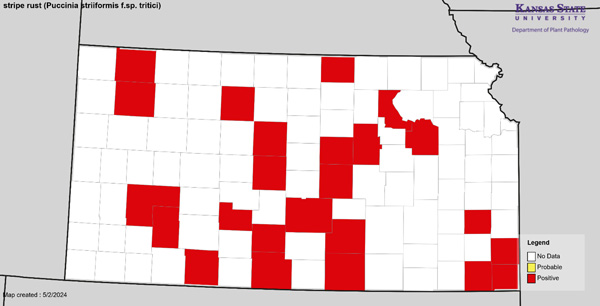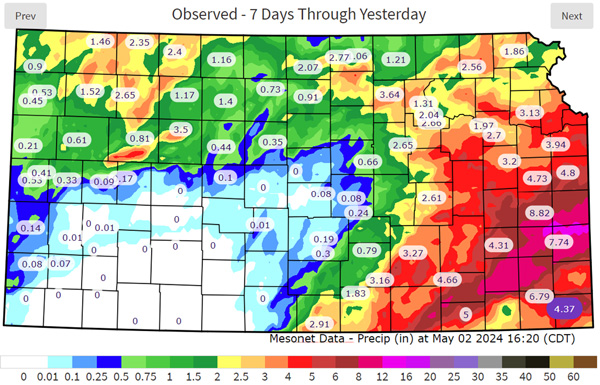The wheat crop is ahead of schedule and there is a dramatic difference in yield potential in parts of the state that have received moisture and parts that have not. Here, we review some key wheat fungicide considerations.
As of May 2, stripe rust has been detected in 24 Kansas counties. It’s important to note that most of these observations have been at very low or trace levels (Figure 1). You can keep up-to-date with reports here: https://wheat.agpestmonitor.org/. Up until this point, the disease has largely been limited by lack of moisture. Reports in the northwest portion of the state are most concerning, as the crop in this region is still in earlier growth stages, and there is ample time for stripe rust to take hold if the environment stays favorable. There are some counties where stripe rust has been detected on flag leaves at an elevated incidence. These fields should be carefully scouted and may be candidates for fungicide applications.
Because the crop is ahead of schedule, many regions in south and south central Kansas have moved past the window for a fungicide application. As a reminder, fungicides have pre-harvest intervals based on growth stages or the number of days before harvest. This publication lists some common fungicides and their pre-harvest intervals: https://bookstore.ksre.ksu.edu/pubs/ep130.pdf. It is always a good idea to consult the label prior to application.

Figure 1. Wheat stripe rust reports as of May 2, 2024 (https://wheat.agpestmonitor.org/). Reports are a collaborative effort between K-State Research and Extension, crop consultants, industry partners, and producers. Additional reports can be sent to andersenk@ksu.edu.
We are now fielding questions about the value of a fungicide application in fields that are between flag leaf and flowering growth stages. Here are some factors to consider as we make those decisions:
- First and foremost, what variety is planted? Varieties rated 3 or below will likely have enough genetic resistance and will not benefit from a fungicide application. Check your variety rating here: https://bookstore.ksre.ksu.edu/pubs/mf991.pdf
- Has disease been detected in the field? If weather conditions are favorable, fields with already established stripe rust are at the highest risk of the disease increasing in the coming days. K-State research demonstrates that if stripe rust is detected on flag leaves at the heading growth stage, there is a 90% chance your fungicide application will pay off. This is a year when scouting will be critical.
- What is the crop's yield potential? Does the yield potential justify an application? K-State research has shown that under moderate to high stripe rust pressure, a fungicide application can provide a 10-15% yield benefit. However, in the absence of disease, we do not expect any economically significant yield benefit from a fungicide application.
- What kind of moisture has been received? As a reminder, it takes about 10 days from the time of infection to symptom development for stripe rust. Areas that have recently received moisture (Figure 2) and are still in the window for a fungicide application (flag leaf to flowering) should be more mindful of scouting over the coming days.
- What is the fusarium head scab risk? Fields approaching early flowering with a history of head scab may be able to use a single application to control both diseases this year. All fungicides that are recommended for head scab are also recommended for stripe rust control. The risk of head scab may be elevated in fields that receive rainfall at or around flowering.

Figure 2. Precipitation observed over the past 7 days according to the Kansas Mesonet (https://mesonet.k-state.edu/). Areas that have received moisture may be at higher risk of stripe rust developing over the coming week.
Leaf rust has now been reported in Oklahoma but has not taken hold in Kansas. We will continue to monitor for it over the coming weeks.
Kelsey Andersen Onofre, Extension Plant Pathologist
andersenk@ksu.edu